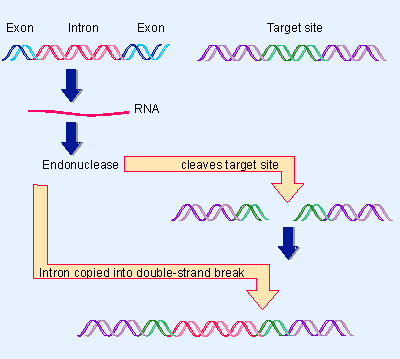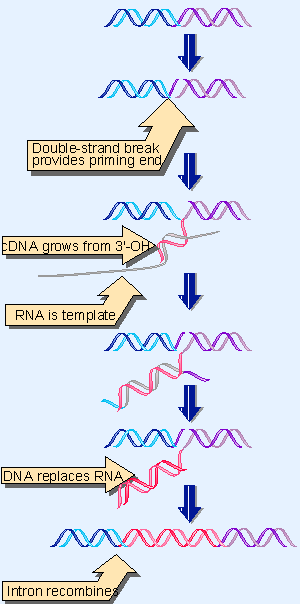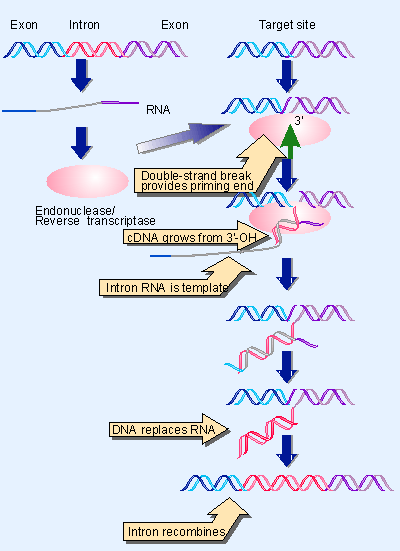6. RNA can have ribonuclease activities
23.5 Some introns code for proteins that sponsor mobility |
Certain introns of both the group I and group II classes contain open reading frames that are translated into proteins. Expression of the proteins allows the intron (either in its original DNA form or as a DNA copy of the RNA) to be mobile: it is able to insert itself into a new genomic site. Introns of both groups I and II are extremely widespread, being found in both prokaryotes and eukaryotes.
Three types of protein functions have been identified in open reading frames of these introns. They are concerned with either DNA or RNA metabolism:
- endonucleases, which cleave at target sites in DNA to allow the insertion of intron sequences;
- reverse transcriptases, which are involved in generating DNA copies of the intronic RNA;
- maturases, which are needed for splicing out the particular intron from the pre-mRNA.
Group I introns that have open reading frames code for endonucleases; sometimes a maturase activity is also associated with the protein. Group II introns that have open reading frames show both endonuclease and reverse transcriptase-like sequences; again, a maturase activity may be associated with the protein. In neither case is there any information about how the maturase function is related to the other enzymatic activities, but the most likely function for the maturase is to stabilize the intron in a conformation that is required for splicing (Carignani et al., 1983).
We know the most about the function of the endonucleases coded by certain group I introns. Their role is to help the intron perpetuate itself in crosses in which the alleles for the relevant gene differ with regard to their possession of the intron.
Polymorphisms for the presence or absence of introns are common in fungal mitochondria. This is consistent with the view that these introns originated by insertion into the gene. Some light on the process that could be involved is cast by an analysis of recombination in crosses involving the large rRNA gene of the yeast mitochondrion.
This gene has a group I intron that contains a coding sequence. The intron is present in some strains of yeast (called ω+) but absent in others (ω V). Genetic crosses between ω+ and ω V are polar: the progeny are usually ω+.
If we think of the ω+ strain as a donor and the ω V strain as a recipient, we form the view that in ω+ ω V crosses a new copy of the intron is generated in the ω V genome. As a result, the progeny are all ω+.
 |
Figure 23.11 An intron codes for an endonuclease that makes a double-strand break in DNA. The sequence of the intron is duplicated and then inserted at the break. |
Mutations can occur in either parent to abolish the polarity. Mutants show normal segregation, with equal numbers of ω+ and ω V progeny. The mutations indicate the nature of the process. Mutations in the ω V strain occur close to the site where the intron would be inserted. Mutations in the ω+ strain lie in the reading frame of the intron and prevent production of the protein. This suggests the model of Figure 23.11, in which the protein coded by the intron in an ω+ strain recognizes the site where the intron should be inserted in an ω V strain and causes it to be preferentially inherited.
What is the action of the protein? The product of the ω intron is an endonuclease that recognizes the ω V gene as a target for a double-strand break. The endonuclease recognizes an 18 bp target sequence that contains the site where the intron is inserted. The target sequence is cleaved on each strand of DNA 2 bases to the 3′ side of the insertion site. So the cleavage sites are 4 bp apart, and generate overhanging single strands.
This type of cleavage is related to the cleavage characteristic of transposons when they migrate to new sites (see 15 Transposons). The double-strand break probably initiates a gene conversion process in which the sequence of the ω+ gene is copied to replace the sequence of the ω V gene. The reaction involves transposition by a duplicative mechanism, and occurs solely at the level of DNA. Insertion of the intron interrupts the sequence recognized by the endonuclease, thus ensuring stability.
Other group I introns that contain open reading frames also are mobile. The general mechanism of intron perpetuation appears to be the same: the intron codes for an endonuclease that cleaves a specific target site where the intron will be inserted. There are differences in the details of insertion; for example, the endonuclease coded by the phage T4 td intron cleaves a target site that is 24 bp upstream of the site at which the intron is itself inserted.
In spite of the common mechanism for intron mobility, there is no homology between the sequences of the target sites or the intron coding regions. We assume that the introns have a common evolutionary origin, but evidently they have diverged greatly. The target sites are among the longest and therefore the most specific known for any endonucleases. The specificity ensures that the intron perpetuates itself only by insertion into a single target site and not elsewhere in the genome. This is called intron homing.
Introns carrying sequences that code for endonucleases are found in a variety of bacteria and lower eukaryotes. These results strengthen the view that introns carrying coding sequences originated as independent elements that coded for a function involved in the ability to be spliced out of RNA or to migrate between DNA molecules. Consistent with this idea, the pattern of codon usage is somewhat different in the intron coding regions from that found in the exons (Zimmerly et al., 1995).
 |
Figure 16.18 Retrotransposition of non-LTR elements occurs by nicking the target to provide a primer for cDNA synthesis on an RNA template. |
Most of the open reading frames contained in group II introns have regions that are related to reverse transcriptases (in addition to the endonuclease regions). Introns of this type are found in organelles of lower eukaryotes and also in some bacteria. The reverse transcriptase activity is specific for the intron, and is involved in homing. The reverse transcriptase generates a DNA copy of the intron from the pre-mRNA, and thus allows the intron to become mobile by a mechanism resembling that of retroviruses (discussed in 16 Retroviruses and retroposons). The type of retrotransposition involved in this case resembles that of a group of retroposons that lack LTRs, and which generate the 3′ VOH needed for priming by making a nick in the target (see Figure 16.18).
 |
Figure 23.12 Reverse transcriptase coded by an intron allows a copy of the RNA to be inserted at a target site generated by a double-strand break. |
Figure 23.12 illustrates the reaction for the example of a group II intron. As before, the endonuclease makes a double-strand break at the target site. A 3′ end is generated at the site of the break, and provides a primer for the reverse transcriptase. The intron RNA provides the template for the synthesis of cDNA. Because the RNA includes exon sequences on either side of the intron, the cDNA product is longer than the region of the intron itself, so that it can span the double-strand break, allowing the cDNA to repair the break. The result is the insertion of the intron (Zimmerly et al., 1995; for review see Lambowitz and Belfort, 1993).
An in vitro system for mobility can be generated by incubating a ribonucleoprotein preparation with a substrate DNA. The ribonucleoprotein includes the RNA containing a group II intron and its protein product. It contains an endonuclease activity that makes a staggered double-strand break at the appropriate target site. Both the RNA and protein components of the ribonucleoprotein are required for cleavage, possibly both in catalytic capacities.
Mobile introns are likely to have been inserted into preexisting genes. They could have evolved into nuclear pre-mRNA introns. Introns with self-splicing capacity could have played an important role in the evolution of splicing; for example, they could have migrated into the nucleus and been the progenitors of snRNAs.
| Reviews | |
| Lambowitz, A. M. and Belfort, M. (1993). Introns as mobile genetic elements. Ann. Rev. Biochem 62, 587-622. | |
| Research | |
| Carignani, G. et al. (1983). An RNA maturase is encoded by the first intron of the mitochondrial gene for the subunit I of cytochrome oxidase in S. cerevisiae. Cell 35, 733-742. | |
| Zimmerly, S. et al. (1995). Group II intron mobility occurs by target DNA-primed reverse transcription. Cell 82, 545-554. | |
| Zimmerly, S. et al. (1995). A group II intron is a catalytic component of a DNA endonuclease involved in intron mobility. Cell 83, 529-538. | |
- Integration Strategies and Tactics for Information Technology Governance
- Linking the IT Balanced Scorecard to the Business Objectives at a Major Canadian Financial Group
- Measuring and Managing E-Business Initiatives Through the Balanced Scorecard
- Measuring ROI in E-Commerce Applications: Analysis to Action
- The Evolution of IT Governance at NB Power